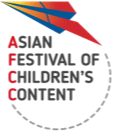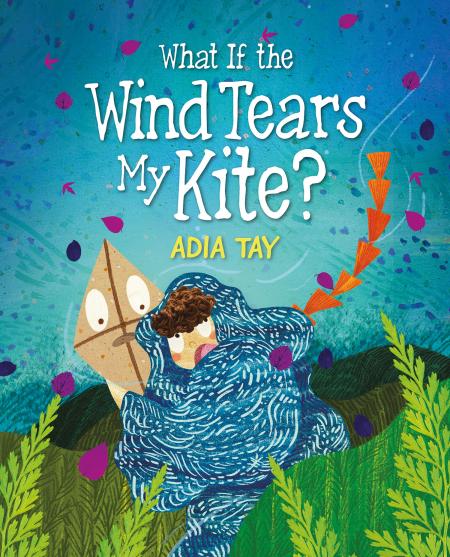What If the Wind Tears My Kite?
By Adia Tay
A lonely boy chances upon a kite and his life changes forever. A newly found kite fills a boy with wonder. Worried that the wind might blow his kite away, he keeps it close. But kites are meant to fly, so the boy flies his kite, only to have the wind carry it away… A beautifully illustrated book about the what-ifs in life.

Adia Tay (Author & Illustrator)
Adia Tay is a singer, songwriter, poet and author. She published her first music album, Kintsugi, and poetry collection, Close Enough, in 2019. And when she isn’t noodling away on her guitar, doodling on paper or brooding over beautiful words, she writes stories for children. What If the Wind Tears My Kite? is her first picture book.
Feature Interview
What if the Wind Tears My Kite? is Adia Tay’s first foray into children’s books. She takes us through the process of creating the book, from the creative choices made on the illustrations to how her past experiences of being a musician all contributed to her completion of the book.
What was the inspiration behind What if the Wind Tears My Kite?
The inspiration behind What if the Wind Tears My Kite really is a sense of freedom. One interesting piece of information about the book is that the book is actually inspired by a composition from long ago. A friend of mine actually wrote a piece called Let Fly the Kite. The book was originally titled Let Fly The Kite as well. And I think the idea of kites, you know, air, freedom, and just the idea of trying to find ourselves in the midst of everything else, was one of the main driving factors of why I decided to do the book.
As much as freedom, there was also this sense of loss when the boy kind of lost his kite, after which he became really sad. Your book does deal with some mature topics. Do you think we should actually shy away from portraying such topics to children, especially in picture books or books for children?
No, I definitely think we shouldn't. In fact, I think children should be able to learn about these topics from as early an age as possible, but in a way that's appropriate for them. I really believe in the power of storytelling when it comes to teaching children. I really believe that kids learn the most and best by engaging storytelling.
While I do feel like difficult topics might be sensitive, and might be slightly more complicated to traverse, that doesn't mean that we should shy away from them. Because I feel like it's very important for kids to understand these things as they grow older as well. When it comes to mental health topics, mental health awareness of kids and their own mental conditions, I think it is so important to help children feel that they're not alone, when it comes to big topics like this as well.
So if a storybook can do that, then you know, great.
What do you hope that children will take away from this story? You know, it could be one could be many, but yeah, some takeaways.
I think the biggest takeaway that I want children to remember after reading the story book is that life always has its ups and downs, but it's always good and always offers you new chances again. And I think for me, one of the best parts of the book, in terms of morals, I guess is that life always presents you with new opportunities. And it's like a river that has a lot of new bends. You never know what it will offer you and present you once you let go and decide to you know, go with the wind, I guess.
Go with the wind. Yeah.
I think one of the key takeaways that I want the book to convey is that life will always present you with new goodness, new opportunities. As long as you just go with the flow, and give yourself the chance to fail, make mistakes, grow, get cuts, fall down, live the journey.
For me when I was writing the book as well, I was in my early 20s and I was feeling very constricted by people's expectations of me as a young adult. Writing the book and illustrating the book was my way of alleviating that sort of, I don't know what word to describe it, but a sense of being in very tight skin, I guess.
So I wanted the book to convey that sense of “just be free, make mistakes, fall down, get up again and grab onto whatever opportunities come by” sort of mindset, I guess for kids,
We'll move on to some questions about the illustration of the picture book now. How did you find your inspiration for the illustrations of this picture book?
I'm very inspired by nature a lot of the time. A lot of my inspiration came from a lot of places, but I really have to thank my editor as well. I tend to work in a very sporadic way, and I get ideas from 1001 different things. My editor's sort of like the funnel, all of the ideas go through and finally sift through into something and finally emerges. But I do tend to get inspired by nature a lot. I think that's one of the biggest, biggest inspirations behind my work. And I think increasingly more so as well with newer works.
This book was also very largely inspired by colour. So interesting nugget: when the book was first sent as a manuscript to my publisher before any work had been done, and I just thought, okay, maybe just give it a go. It was all in black and white and it was actually done in a much more adult way, black-and-white-minimalist-sort-of-way. It was slightly more for adults as well. The publisher saw something that was great for kids books, I think.
I don't know how my editor saw it as well, but I'm so glad that she did. So I will say that my inspiration really comes twofold. First of all, nature and the sporadic chattering monkeys in my head; they say a lot of things as well. And also, just the inspiration and the guidance that my editor has lent me as well have been key in creating this book.
What kind of techniques did you use in this book to convey the story? You were saying that the book was actually in black and white and it was with the editor's input that you decided to add colour to it… So what were some of the creative decisions that were made when creating the book?
I think the first one was definitely that we needed to choose a style that would be approachable for children. As an artist, I think I tend I do tend toward very minimalist, (I'm not minimalist by any means) but I do tend to go for something that is very stylistic, more minimalistic. Something that's a bit more modern when it comes to my illustrations.
This was my first kids book and my first time dealing with editors, publishing, and all that. I did not realise before how much colour really comes into play. Not that I'm colourblind, or that I haven't lived in this world full of colour but you do see a lot of more stylistic books out there as well, Shel Silverstein’s The Giving Tree being one of the foremost examples of this sort of book. And also you have Quentin Blake, all these very, I wouldn't say adult illustrations, but they do have a sort of more adult quality to them. I think part of it lies in the simplicity of it.
I definitely was not as free with colour before I started working on this book. It was through the help of my editor as well that I realised that colour is not necessarily always kiddish. I know it might seem a bit strange that I illustrated the book, not wanting to have a lot of colour. But I think this first book has definitely helped me to understand how to use colour a lot more efficiently.
Because it's my first book and I was also doing this book in Singapore, in the Maldives, in the UK around a lot of different places and my publisher was always going, “Where are you now? Can we call?” I think the process itself was also a bit strange because every single time I moved to a new country, I would have new insights or new ideas about how I wanted to do my book.
I felt like this book kept changing with me as I was progressing as a children's illustrator as well. If I have to use one word, or one phrase, the whole process was in a flux the whole time. But yeah, learning to deal with colour, learning to use colour to my advantage and realising just how important it is for kids.
You mentioned that your experience with children's books is that it's really about colour and the kind of the use of colouring? How is it writing and/or illustrating for children, and how does it differ from what you have actually done before?
I have done writing and illustration for adults before. Apart from being a children's book Illustrator and author, before COVID actually even hit, I have been a musician for a very long time, I've been playing in bars, venues, and I do also write my own songs. I have a whole album out. I think I released it in 2018. I cannot remember. But I do write lyrics for young adults, essentially.
So writing this kid's book, I remember definitely at the beginning, having to pare down all of the stuff that was not needed, and also having to make it more accessible for children. One important thing that I learned was: how do I make this particular piece of text educational as well? Because I think kids books definitely need to have that element in them as well. Because, you know, it's for children, right, and they are sponges.
I have been making art for a long time, but more for adults. And I realised also that that has helped me actually, that has not been contradictory to the kids book process. Because I feel like at the end of the day, it's about learning how to connect with the person who's reading. That has definitely helped for my first picture book. I've definitely been aided by my past experience before.
Check out What If the Wind Tears My Kite? at our Festival Bookstore now!

